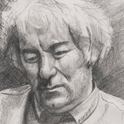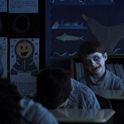Daniel Day-Lewis in Steven Spielberg's Lincoln (2012)
Some years back, I took a trip into the heart of Spielberg country with one of my daughters: we boarded a small craft on the Jurassic Park ride at Universal Studios in California. Universal gave Steven Spielberg his first directing job in the late 1960s. For decades they made his films—through sharks, aliens, dinosaurs, whip-cracking adventures, war, history and back to sci-fi—and he has helped them construct their rides, acting as creative consultant to the Studio Tour which draws heavily on his films.
The sky was pewter-grey, spitting large drops. Two in a craft which might have taken a dozen, we bobbed along through milky-blue waters scented of bleach, towards a “scientific compound.” Here, we were told, a group of lab geeks had managed to create dinosaurs through cloning. The conceit, as in the film, was that the dinosaurs had escaped their cages and were now roaming free, through a landscape of jungle, mesh fences and warning signs. We entered a hangar: a siren went off and we were instructed that a lethal substance would be released to rid the area of a dangerous predator. It was clear that soon we were to be expelled from this sinister structure, through the hangar doors and down the advertised “84-foot death-defying raft plunge.” Five minutes passed. By now I could discern the mass of the mechanical beast that would lunge at us just before the fall. I could also see figures high above scurrying with jerky haste in a control room, pointing and talking into communications units. Was this pantomime or genuine equipment malfunction? We were stuck in Jurassic Park hell and at least one of us was a little teary. This was not exactly the thrill as billed.
Nor was it the first time Spielberg—director, producer, co-founder of Dreamworks Studio—had made me uneasy. The man who once described his first huge 1970s success, Jaws, as analogous to “directing the audience with an electric cattleprod” had found ways over the decades to unsettle my prejudices of him as a master-manipulator. Now, he has delivered Lincoln, a sombre political procedural that both harks back to The Birth of a Nation (1915), DW Griffith’s seminal, if politically repellent, story of the civil war and reconstruction era in America, and points outwards to the pressing concerns of the Obama era. The film is grand but complex, canny and sincere. And increasingly, as the years go by, I find there is more mystery and doubt than I first suspected in the work of this most influential of filmmakers. If Spielberg were more intellectual or more gnomic in discussing his films, he might be regarded not as a mass-market wizard but as a cult director.
My first encounters with Spielberg came as a teenager. I had been freaked out by Jaws (1975) and impressed by Close Encounters of the Third Kind (1977) but by the time I saw ET (1982), I was wary. Spielberg employed his dazzling ability with such calculation—always to ensure the maximum production of adrenaline, anxiety or tears—that I was constantly on my guard. ET left me cold. Martin Amis, dispatched to a Los Angeles cinema to document the reactions of this blockbuster tearjerker, recorded his own “grief and bewilderment” and that of fellow audience members: “executive, black dude, Japanese businessman, punk, hippie, mother, teenager, child. Each face was a mask of tears.” But not mine. Stung by the filmmaker’s cattleprod, I ran the wrong way. I could admire the composition of the story of little Elliott, child of a fractured home, who befriends the oyster-eyed alien; I could appreciate the evocation of wonder, the commentary on science and belief, yet I baulked at the manipulation. Why did its subject have to be a cute alien with a toddler’s walk and a baby’s disproportionately large eyes? Wasn’t that too easy? ET made me cross: it was a film about tolerance I couldn’t stand.
I began to detest that ubiquitous Spielbergian blue lighting, harbinger of the poignant or spectacular, that spread widely through 1980s cinema. Spielberg’s signature themes could set my teeth on edge—those threatened families, those tableaux of reunion, characters caught slack-jawed with terror or awe, the curiously desexualised women, even the artistry of John Williams’ scores. By then, I had seen and liked Spielberg’s earliest features, Duel (1971) and the surprisingly sour Sugarland Express (1974); that was the kind of American director I admired. Duel, about a man relentlessly pursued on the road by the unknown driver of a monster truck, was bleak and existential. It would not have been out of place in a European arthouse. Its protagonist (a man called Mann) was like a character from a Michelangelo Antonioni or Jean-Pierre Melville film.
A year after Sugarland Express, of course, Spielberg went on to create our current notion of the blockbuster in 1975 with Jaws. His stated preference was for film ideas that “you can hold in your hand.” Jaws was the Big Shark movie that became a cultural phenomenon, brushing aside high and low-brow labels and setting box office records in its opening weeks. In the film, a group of ordinary people (neither princes nor uniformed heroes) do battle with an extraordinary threat; the observational detail of the ordinariness made it gripping and plausibly scary. But once the “event” films took hold, from Star Wars onwards into the 1980s, it seemed Spielberg had become a brazen evangelist for an America—triumphalist, smug and expensively marketed—of which I was fashionably critical. Spielberg was a man, after all, who had enacted the American dream: no film school radical, he was a Cincinnati kid, without connections, who had put on a suit, found his way into an office at Universal and simply sold the bosses the idea that he should make movies. His movies were just commercial products, surely. Even the films of conscience, like The Color Purple (1985) were weakened by a sentimentality that ultimately let us off the hook and made them forgettable. These were films held in his hand, skilfully controlled and, to me, unengaging.
But I was overlooking something. Spielberg, the master of mass entertainment, director of mega-stars like Harrison Ford, Tom Hanks and Tom Cruise, was also making films that could be successful and odd, troubling and contradictory. Psychoanalytical criticism of his work concentrated on the personal—his parents’ divorce, the absent fathers and preoccupied mothers on screen—but beyond that increasingly lay darker themes. Like David Lynch or David Cronenberg or Tim Burton, he found the sinister in the suburban, the strangeness in the details, and a fundamental dislocation from everyday life.
The first film that really made me notice Spielberg’s talent for smuggling these subversive qualities into mainstream cinema was Empire of the Sun (1987). As an admirer of JG Ballard’s writing, I had not expected to like Spielberg’s visualisation of this semi-autobiographical novel of ex-pat Brits in war-time Shanghai and Japanese internment. I postponed seeing it for some years but when I did, I found it satisfyingly strange. In part, this comes from the casting of Christian Bale, whose intense energy runs through almost every scene—but the film is also a skilful cinematic realisation of a novel, wordless for minutes on end. In the Shanghai scenes above all, it has a distinctive gliding quality. The progress through the streets in the grand family Packard reflects the child’s viewpoint while providing a metaphor for the individual’s passage through the tumult of war. As an example of cinematic alienation, it now seems more effective and unforced than, say, Cronenberg’s recent Cosmopolis (2012).
That detachment is the key to Schindler’s List (1993), Spielberg’s cautious approach to the Holocaust. This is necessarily a film about evasion, about those on the List who escaped the greatest atrocity of the 20th century; its effect derives from what we do not see and can barely imagine. Amongst contemporary reviews, the Washington Post remarked with admiration on the “emotional numbness” the film engendered. Kenneth Turan, in the Los Angeles Times, noted approvingly the “detachment and self-control almost to the point of coldness.” In this case, the control only emphasises the terrible chaos beyond.
With Artificial Intelligence: AI (2001) Spielberg took Brian Aldiss’s vivid, cruel and very short story about a little android, David, who begins to suspect that he is not a real boy. Writing for the first time in decades, Spielberg vastly expanded the narrative. The best of it is a seductive nightmare vision of New York submerged, the very symbols of American dominance drowned in the risen sea. Spielberg’s follow-up, Minority Report (2002), a spectral sci-fi adapted from Philip K Dick, also has moments of surreal body horror on a par with Lynch or Cronenberg.
After Minority Report he admitted he was in a period of experimentation, challenging himself and the audience. “I’m striking out in all directions trying to find myself, trying to discover myself. In my mid-fifties!” In 2002 he took a bittersweet 1960s-tribute caper, Catch Me If You Can, and subverted the Hollywood ideal of the self-made man with the story of a compulsively deceitful youth who pretended (with some success) to be an airline pilot. In The Terminal (2004), Spielberg cast one of the world’s most loved Americans, Tom Hanks, as a dispossessed Eastern European forced to live in JFK airport. Had it been directed by a European, the story might have been told as an austere meditation on statelessness. Spielberg made it a romantic comedy. But beneath the schmaltz, the film suggests an America that unthinkingly kicks rather than welcomes huddled masses and which may not in any case have much to offer them beyond shopping. This bleak heresy is smuggled past an audience who came in to see a Tom Hanks movie. Sure, Spielberg can still deliver cloying sentimentality but the lurid excess of War Horse, for example, is cut through by one stunning sequence of a horse fleeing through No Man’s Land. Chaos, again.
And Lincoln is a strange, bleak film. Did Spielberg imagine many movie-goers would recognise the huge cast of politicians caught up in Abraham Lincoln’s manoeuvres to get the 13th Amendment through the House of Representatives? At the preview screening I attended, a sheet with thumbnail headshots was provided so you could tell your Robert Latham from your Richard Schell (under the whiskers, one’s John Hawkes, the other’s Tim Blake Nelson—this is another Spielberg film where dozens of fine actors are glimpsed for just a moment).
For all the monumentality of its subject, Lincoln is unconventional. It rejects the cradle-to-grave biopic rules for a detailed study of the final four months of the president’s life, even refusing to show the assassination. What it does, thanks to the remarkable central performance, is bring that vast statue that presides over Washington down to life-size, animating it not with “greatness” but the sheer struggle of life and work of this weary, grieving, yearning individual. Lincoln is less an idealist than an inventive and effective manipulator, trying to impose order amid conflict and destruction. The domestic scenes are claustrophobic and gloomy, unsettling in their detail, steeped in death recalled and anticipated.
Barack Obama has seen the film at least twice and describes it as “extremely powerful.” The film landed three days after Obama won his second term as president and explores political accommodation and negotiation, the importance of “setting a direction” for policy. Lincoln is not devoid of sentiment; early on there is a conversation between the president and two soldiers (one of them black) that threatens to be the cinema equivalent of a moralising tableau. But the detailed business of politics soon intervenes. In an age of soundbites and presidential tweets, Spielberg wants us to focus on the otherwise invisible “works.”
And that is his achievement: to use his Hollywood skills to get some bizarrely un-Hollywood material past us. When I spoke to him recently, he cheerfully spoke of the “popcorn movie” that would be his next project after Lincoln. Then again, his idea of “popcorn movie” might surprise one. The Universal Studio tour also contains another “attraction” from the Spielberg archive. It is the plane crash site from War of the Worlds (2005), HG Wells updated after 9/11. A smoking fuselage sits on a hillside, surrounded by suitcases burst open, life jackets, the odd shoe and toy from its missing passengers—more ordinary detail rendered surreal. Tourists pass close by in little carts, many of them contemplating their own imminent flight home. It’s a strange way to have fun, with this vast momento mori, but Steven Spielberg has never really been in the business of comfort.












